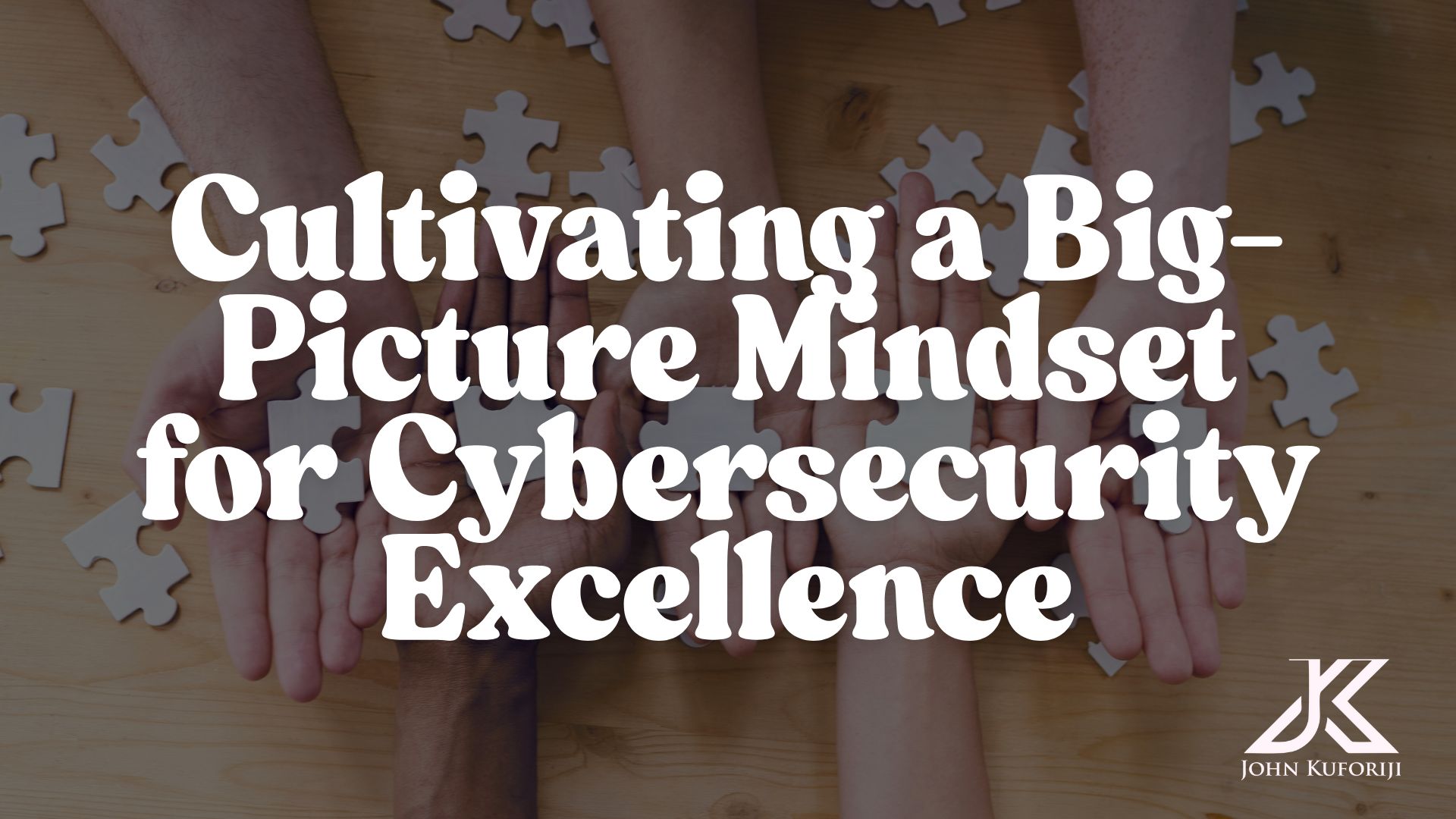
On my flight back home from work recently, I was reading John C. Maxwell’s book, How Successful People Think. Chapter 1, titled “Cultivate Big-Picture Thinking,” struck a chord with me—particularly in relation to my work in cybersecurity. As I pored over Maxwell’s insights, I couldn’t help but draw parallels between big-picture thinking and the approach organizations often take toward their security challenges. Many of us still adopt a “micro” strategy, focusing on individual issues and risks without recognizing the vast and interconnected nature of modern cyber threats. This narrow perspective ultimately hinders our ability to protect our organizations effectively, and it perpetuates the outdated notion that the cybersecurity department is merely a cost center.
Below, we’ll explore why it’s crucial to move away from these micro-risk tactics and embrace a holistic strategy. We’ll also look at how this shift can help transform cybersecurity teams into centers of excellence—catalysts for innovation and strategic growth rather than reactive cost sinks.
The Interconnected Nature of Cybersecurity Risks
Beyond isolated threats
As Maxwell’s chapter on big-picture thinking reminds us, stepping back to see the broader landscape is essential—particularly in cybersecurity. Today’s threats are multifaceted; a single breach can trigger ripple effects that compromise multiple systems, harm reputation, and even invite legal consequences. Focusing on isolated risks (e.g., a single phishing campaign or a specific malware variant) can blind organizations to these larger implications.
Moreover, with businesses increasingly reliant on cloud-based services, remote work, and the Internet of Things (IoT), there are more avenues of attack than ever before. Traditional boundaries are blurred—organizational assets now span on-premises infrastructure, cloud environments, and employees’ personal devices. A micro perspective in such a fluid ecosystem often leaves hidden vulnerabilities unaddressed.
The pitfalls of a micro approach
Micro approaches to cybersecurity tend to arise from departmental silos. One team might fixate on patching operating system vulnerabilities, while another focuses on privacy regulations, and yet another on firewalls. This “Whac-a-Mole” tactic might address pressing issues quickly, but it neglects systemic weaknesses.
- Fragmented Visibility: Siloed teams use different tools, metrics, and processes, resulting in inconsistent security practices across the organization.
- Resource Drain: Responding to every threat in an ad-hoc manner can be more costly in the long run than making strategic, proactive investments.
- Stunted Growth: A narrow focus limits the ability to adopt innovative technologies, since new initiatives might introduce unknown risks that aren’t clearly visible through a micro lens.
Embracing a Broader View of Cybersecurity
Aligning cybersecurity with business objectives
The first step in cultivating a big-picture mindset is recognizing that cybersecurity is an enabler of business success, not merely a defensive necessity. CISOs should engage with each department to understand their goals—whether it’s rolling out a new e-commerce platform, enhancing customer data analytics, or automating HR workflows. Security measures must facilitate these objectives rather than block or delay them. By doing so, security teams become strategic partners who empower innovation within safe boundaries.
Implementing a risk-based framework
To break free from the trap of point solutions, organizations should adopt a risk-based approach that addresses the entire threat surface:
- Comprehensive Risk Assessments: Map all assets, data repositories, and third-party connections. Assess vulnerabilities and potential impacts to prioritize mitigation.
- Security by Design: Integrate security considerations at every stage of system and product development. This proactive measure reduces the likelihood of expensive fixes later.
- Threat Intelligence & Continuous Monitoring: Use real-time analytics and updates on emerging threats to pivot quickly as new risks appear.
- Collaborative Vulnerability Management: Involve all relevant teams when prioritizing vulnerability patches, ensuring alignment with business-critical systems.
Fostering a culture of shared responsibility
Big-picture cybersecurity hinges on organization-wide participation. Every employee, from frontline staff to executive leaders, should understand the role they play:
- Regular Training & Awareness: Conduct interactive sessions, simulated phishing exercises, and ongoing awareness campaigns to keep security top of mind.
- Open Communication Channels: Break down departmental silos by encouraging cross-functional collaboration. Legal, HR, and IT should coordinate on policies, incident response, and risk management strategies.
- Leadership Endorsement: Executives must champion cybersecurity initiatives, model best practices, and allocate resources proportionate to the organization’s risk profile.
Transforming Cybersecurity from a Cost Center to a Center of Excellence
Building agility into security operations
In an environment where threats evolve at a breakneck pace, agility is paramount. Standardizing processes, automating repetitive tasks (e.g., threat detection or patch deployments), and leveraging scalable cloud platforms empower security teams to respond rapidly. This agility ensures minimal disruption during incidents and fosters a proactive stance that can avert larger crises.
Investing in innovation
By adopting a big-picture perspective, cybersecurity teams can identify opportunities for innovation:
- Advanced Analytics & AI: Machine learning algorithms can sift through massive datasets to detect unusual patterns, helping to predict and neutralize threats before they escalate.
- Experimental Sandboxes: Safe, isolated environments allow teams to test new security tools and strategies, revealing hidden vulnerabilities without endangering production systems.
- Penetration Testing & Red Teaming: Regularly simulating attacks can uncover weaknesses, build muscle memory for incident response, and bolster the overall security posture.
Demonstrating tangible value
A key to shedding the “cost center” label is showcasing measurable outcomes linked to business objectives:
- Risk Reduction Metrics: Move beyond abstract numbers (e.g., total alerts) to illustrate direct impact, such as lowered incident response times or a measurable decrease in unauthorized data access.
- Strategic Contribution: Highlight how security enables expansion into new markets, supports regulatory compliance, or enhances customer trust—concrete results that directly affect revenue and reputation.
- Success Stories: Share case studies of how timely threat detection, improved risk posture, or collaborative efforts saved the company from potential breaches or regulatory fines.
Cultivating strategic partnerships
Big-picture thinking also extends outside the walls of your organization. Consider:
- Industry Collaboration: Join cybersecurity consortia or sharing initiatives to collectively tackle emerging threats.
- Government & Regulatory Bodies: Foster relationships with relevant agencies for up-to-date intelligence, guidance, and potential support in the event of large-scale attacks.
- Vendor & Supplier Networks: Maintain close alignment with critical suppliers to ensure shared accountability and best practices across the supply chain.
Conclusion
Reading John C. Maxwell’s perspective on big-picture thinking served as a timely reminder that focusing on the broader view is not just beneficial, but necessary in cybersecurity. A micro approach may offer quick fixes, but it is unsustainable in a threat landscape as expansive and interconnected as today’s. By aligning cybersecurity with business objectives, implementing risk-based frameworks, and fostering an organization-wide culture of responsibility, CISOs can propel their teams to become centers of excellence—vital contributors to innovation and growth, rather than isolated cost centers.
When we zoom out, we see that cybersecurity underpins trust and success in the digital age. It’s time to adopt a big-picture mindset, cultivating an environment where both security and strategic objectives flourish side by side. By doing so, organizations will not only strengthen their defenses but also unlock new opportunities for creativity and resilience in the face of relentless cyber challenges.
